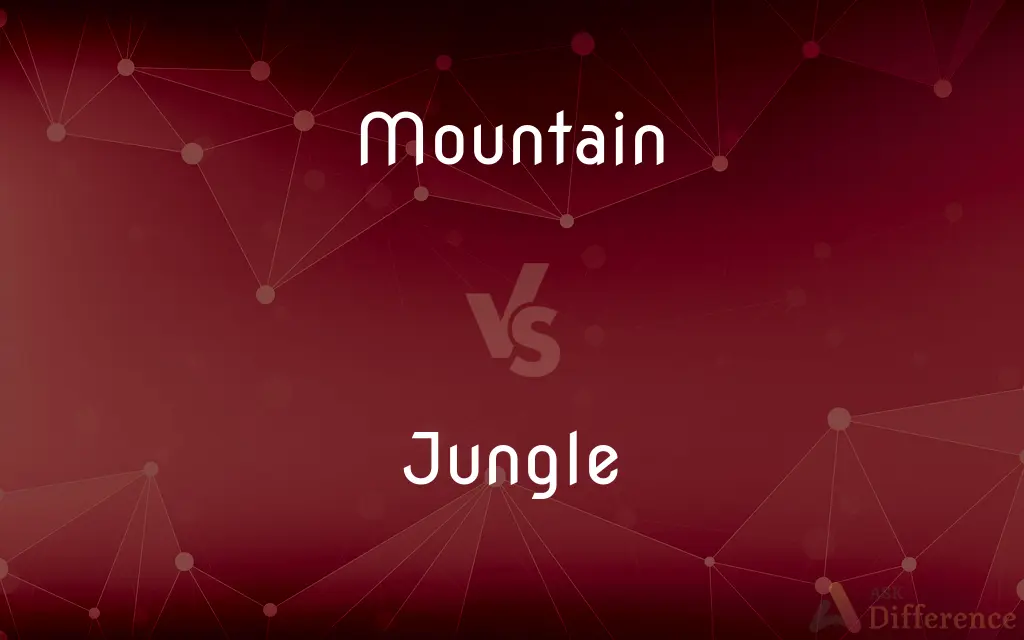Mountain vs. Jungle — What's the Difference?
Edited by Tayyaba Rehman — By Urooj Arif — Updated on April 3, 2024
Mountains are elevated landforms with high peaks, often characterized by cooler climates, while jungles are dense, tropical forests with high biodiversity and warm, humid conditions.

Difference Between Mountain and Jungle
Table of Contents
ADVERTISEMENT
Key Differences
Mountains are formed through tectonic forces or volcanism, leading to elevated terrains with significant height differences. They are often characterized by a series of ecosystems as altitude increases, from temperate forests to alpine conditions. In contrast, jungles, typically located near the equator, feature dense tree coverage, high rainfall, and a warm climate year-round, supporting a diverse array of flora and fauna.
While mountains can affect the climate of an area by blocking wind and precipitation, creating varied microclimates on their leeward and windward sides, jungles act as Earth's lungs, producing large quantities of oxygen and absorbing carbon dioxide. The distinct climatic conditions of mountains result in unique biodiversity with species adapted to cooler, often harsher environments. On the other hand, jungles are among the most biodiverse ecosystems on the planet, home to a significant proportion of the world's species.
Mountains offer activities like hiking, skiing, and mountaineering, attracting tourists seeking adventure and natural beauty. They also play a crucial role in water cycles, storing water as snow and ice, which, when melted, supplies fresh water to rivers and lakes. Jungles, meanwhile, are explored for their unparalleled biodiversity, offering opportunities for ecotourism and research on various species and their habitats. They also play a critical role in regulating global weather patterns and storing vast amounts of carbon, mitigating climate change.
The human habitation in mountainous areas often adapts to challenging terrains, leading to unique cultures and ways of life, such as terraced farming on slopes. In jungles, indigenous communities have developed lifestyles deeply interconnected with the forest, practicing sustainable living methods and possessing extensive knowledge of the medicinal and nutritional value of plant species.
Infrastructure development in mountains is challenging due to rough terrains and risks of landslides and erosion, often leading to isolated communities. In jungles, the dense vegetation and climate pose challenges for development, with concerns about deforestation and biodiversity loss due to expanding human activities.
ADVERTISEMENT
Comparison Chart
Location
Global, often in ranges
Tropical regions near the equator
Climate
Varied with altitude; generally cooler
Warm, humid year-round
Biodiversity
Unique, adapted to cooler climates
Extremely high, diverse species
Human Interaction
Tourism, habitation adapted to terrain
Ecotourism, indigenous communities closely tied to ecosystem
Environmental Role
Affect local climate, water storage
Produce oxygen, carbon storage, regulate weather patterns
Challenges
Rough terrain, altitude sickness
Deforestation, biodiversity loss
Activities
Hiking, skiing, mountaineering
Ecotourism, research on biodiversity
Compare with Definitions
Mountain
Sites for adventure tourism and sports.
The Alps are popular for skiing and mountaineering.
Jungle
Locations for ecotourism and biological research.
Borneo's jungles attract scientists studying biodiversity.
Mountain
Natural barriers affecting weather and climate.
Mountains block rain, creating dry shadows on their leeward sides.
Jungle
Habitats with complex food webs and ecological interactions.
Jungles support intricate relationships between species.
Mountain
Elevated landforms with significant height above sea level.
The Rockies offer breathtaking mountain landscapes.
Jungle
Ecosystems characterized by high rainfall and humidity.
Jungles receive rainfall throughout the year, maintaining their lushness.
Mountain
Sources of rivers and fresh water.
Many rivers originate from mountain springs, providing fresh water.
Jungle
Crucial areas for carbon storage and oxygen production.
Tropical jungles play a key role in Earth's carbon cycle.
Mountain
Areas characterized by cooler climates and diverse ecosystems.
Mountains can host snow at higher altitudes even in summer.
Jungle
Dense, tropical forests with high biodiversity.
The Amazon jungle is home to countless species of flora and fauna.
Mountain
A mountain is an elevated portion of the Earth's crust, generally with steep sides that show significant exposed bedrock. A mountain differs from a plateau in having a limited summit area, and is larger than a hill, typically rising at least 300 metres (1000 feet) above the surrounding land.
Jungle
A jungle is land covered with dense forest and tangled vegetation, usually in tropical climates. Application of the term has varied greatly during the past recent centuries.
Mountain
Abbr. Mt. or Mtn. A natural elevation of the earth's surface having considerable mass, generally steep sides, and a height greater than that of a hill.
Jungle
Land covered with a dense growth of tropical vegetation.
Mountain
A large heap
A mountain of laundry.
Jungle
A dense thicket or growth.
Mountain
A huge quantity
A mountain of trouble.
Jungle
A dense, confused mass; a jumble.
Mountain
(countable) An elevation of land of considerable dimensions rising more or less abruptly, forming a conspicuous figure in the landscape, usually having a small extent of surface at its summit.
Everest is the highest mountain in the world.
We spent the weekend hiking in the mountains.
Jungle
Something made up of many confused elements; a bewildering complex or maze
Sorting through the jungle of regulations.
Mountain
(countable) Something very large in size or quantity; a huge amount; a great heap.
He was a real mountain of a man, standing seven feet tall.
There's still a mountain of work to do.
Jungle
A place or milieu characterized by intense, often ruthless competition or struggle for survival
The corporate jungle.
Mountain
(figuratively) A difficult task or challenge.
Jungle
(Slang) A place where hoboes camp.
Mountain
Wine from Malaga made from grapes that grow on a mountain.
Jungle
A large, undeveloped, humid forest, especially in a tropical region, that is home to many wild plants and animals; a tropical rainforest.
Mountain
(cartomancy) The twenty-first Lenormand card.
Jungle
(South Asia) Any uncultivated tract of forest or scrub habitat.
Mountain
A large mass of earth and rock, rising above the common level of the earth or adjacent land; earth and rock forming an isolated peak or a ridge; an eminence higher than a hill; a mount.
Jungle
(colloquial) A place where people behave ruthlessly, unconstrained by law or morality.
It’s a jungle out there.
Mountain
A range, chain, or group of such elevations; as, the White Mountains.
Jungle
(figurative) A tangled mess.
Mountain
A mountainlike mass; something of great bulk; a large quantity.
I should have been a mountain of mummy.
Jungle
(slang) An area where hobos camp together.
Mountain
Of or pertaining to a mountain or mountains; growing or living on a mountain; found on or peculiar to mountains; among mountains; as, a mountain torrent; mountain pines; mountain goats; mountain air; mountain howitzer.
Jungle
(UK) A migrant camp.
Mountain
Like a mountain; mountainous; vast; very great.
The high, the mountain majesty of worth.
Jungle
A style of electronic dance music and precursor of drum and bass.
Mountain
A land mass that projects well above its surroundings; higher than a hill
Jungle
A desert region.
Mountain
A large number or amount;
Made lots of new friends
She amassed a mountain of newspapers
Jungle
Dense rough.
Tiger country
Mountain
Relating to or located in mountains;
Mountain people
Jungle
A hairy vulva.
Jungle
(Of musical beat, rhythm, etc.) resembling the fast-paced drumming of traditional peoples of the jungle.
Jungle
A dense growth of brushwood, grasses, reeds, vines, etc.; an almost impenetrable thicket of trees, canes, and reedy vegetation, as in India, Africa, Australia, and Brazil.
The jungles of India are of bamboos, canes, and other palms, very difficult to penetrate.
Jungle
A place of danger or ruthless competition for survival.
Jungle
Anything which causes confusion or difficulty due to intricacy; as, a jungle of environmental regulations.
Jungle
An impenetrable equatorial forest
Jungle
A location marked by an intense competition and struggle for survival
Jungle
A place where hoboes camp
Common Curiosities
What role do mountains and jungles play in climate regulation?
Mountains affect local weather patterns and climates, while jungles help regulate global temperatures and weather patterns.
Why are both mountains and jungles important for biodiversity?
Mountains and jungles host unique ecosystems, providing habitats for diverse species adapted to specific climatic conditions.
How do human activities impact mountains and jungles?
Activities like tourism, deforestation, and infrastructure development can impact the natural environments of mountains and jungles, potentially leading to biodiversity loss.
What differentiates a mountain from a jungle?
A mountain is an elevated terrain with cooler climates and diverse ecosystems with altitude, while a jungle is a dense forest in tropical regions with high biodiversity and humidity.
Can mountains and jungles coexist in the same region?
Yes, in some parts of the world, mountains with lush vegetation can host jungle-like environments at lower altitudes.
What is the importance of rivers originating from mountains?
Rivers from mountains are crucial for providing freshwater resources for drinking, agriculture, and sanitation.
How do mountains and jungles contribute to the Earth's water cycle?
Mountains store water as snow and release it into rivers, while jungles contribute to the water cycle through transpiration.
How are mountains formed?
Mountains are formed through tectonic forces and volcanic activity, leading to the uplift of landmasses.
What are the challenges of living in mountainous areas compared to jungles?
Mountainous areas present challenges like rough terrain and altitude sickness, while jungles pose difficulties related to humidity, dense vegetation, and potential for disease.
What makes jungles so biodiverse?
The warm, humid climate and high rainfall in jungles create ideal conditions for a wide variety of plant and animal life.
What are the benefits of preserving mountains and jungles?
Preserving these ecosystems ensures the protection of biodiversity, supports climate regulation, and maintains essential natural resources.
Why are jungles often called the lungs of the Earth?
Jungles are termed Earth's lungs because they produce a significant amount of oxygen and absorb carbon dioxide.
How do ecosystems vary with altitude in mountains?
As altitude increases, mountain ecosystems transition from temperate forests to alpine conditions, each hosting distinct flora and fauna.
How do indigenous communities interact with jungles?
Indigenous communities rely on jungles for their livelihood, utilizing traditional knowledge for sustainable living and conservation.
What measures are being taken to protect mountains and jungles?
Conservation efforts, protected areas, and sustainable practices are employed to protect the unique ecosystems of mountains and jungles.
Share Your Discovery

Previous Comparison
Arrested vs. Busted
Next Comparison
Mystery vs. MysteriousAuthor Spotlight
Written by
Urooj ArifUrooj is a skilled content writer at Ask Difference, known for her exceptional ability to simplify complex topics into engaging and informative content. With a passion for research and a flair for clear, concise writing, she consistently delivers articles that resonate with our diverse audience.
Edited by
Tayyaba RehmanTayyaba Rehman is a distinguished writer, currently serving as a primary contributor to askdifference.com. As a researcher in semantics and etymology, Tayyaba's passion for the complexity of languages and their distinctions has found a perfect home on the platform. Tayyaba delves into the intricacies of language, distinguishing between commonly confused words and phrases, thereby providing clarity for readers worldwide.















































